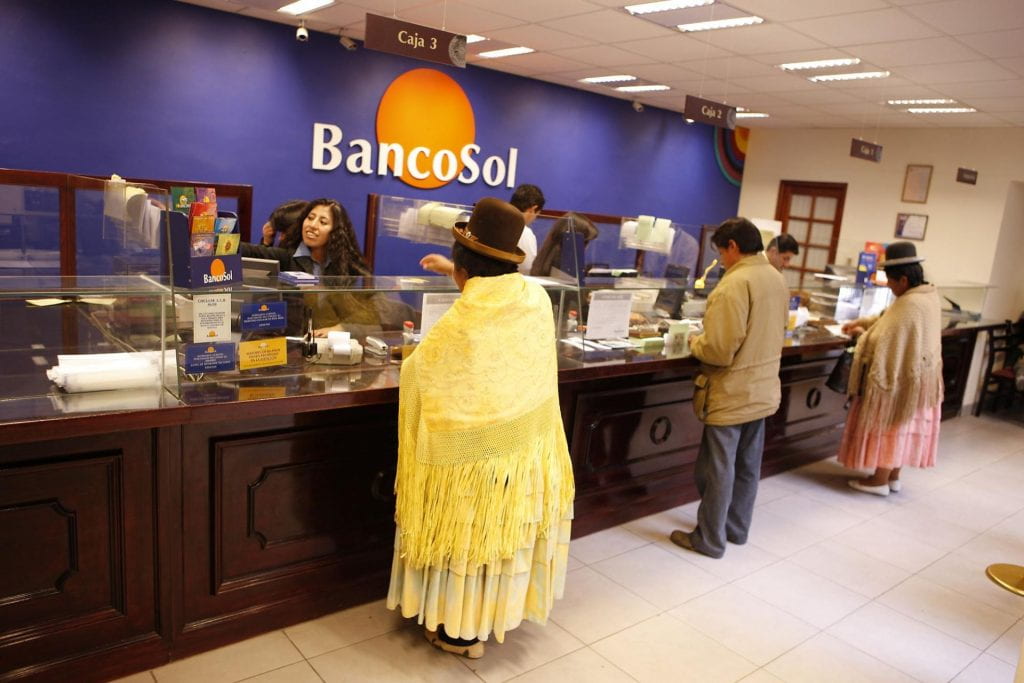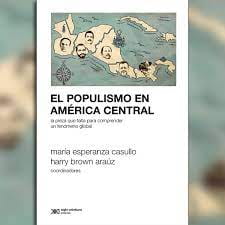Microfinance
A World-Class Performance
When I first saw the photos of the sacking of BancoSol, I cried. The slide show began with chaotic pictures of the mob hauling desks, computers and files into the street and setting them on fire. Next were two captured looters lying face down and handcuffed amid the wreckage of what hours before had been a functioning bank branch. Finally, next-day photographs documented the ravaged premises of BansoSol’s branches all over La Paz and El Alto.
Thinking back to 2003 when these events occurred, I ask three questions. Why did protestors ransack a socially motivated bank that lends to the poor? Why did that make me cry? And what has become of BancoSol and the rest of the microfinance sector since then?
Development economist Claudio González-Vega once said of microfinance in Bolivia, “One could not write the recent economic history of Bolivia without highlighting microfinance, and one could not write the world history of microfinance without highlighting Bolivia.” (Boulder Finance Institute presentation, July 2007). Microfinance is one of Bolivia’s best claims to a world-class performance. It started in the late 1980s when idealistic Bolivian social activists created a series of microfinance institutions (MFIs). They found a ready market for small loans among Bolivia’s enormous informal sector, dominated by Aymara-speaking microentrepreneurs. The need, the services and the culture somehow clicked, and these MFIs quickly grew into leaders in the emerging global microfinance sector.
Among the Bolivian MFIs, BancoSol was the flagship. It started as Prodem, an NGO promoted by U.S. non-profit ACCION International, with grants from USAID and the Inter-American Development Bank. In 1992, after five years of unexpectedly rapid growth, Prodem sought a bank license from the Bolivian authorities and created BancoSol, Latin America’s first private commercial bank exclusively devoted to microenterprises. BancoSol’s example spawned a half dozen similar transformations in Bolivia, creating a commercial microfinance sector. More importantly, the Bolivian model led to the transformation of dozens of MFIs around the world, launching the expansion of microfinance from a few tiny, donor-driven programs to a global industry that today brings access to financial services to 150 million people.
For me, BancoSol symbolized the best achievements of microfinance. As one of the first wave of people to stake my professional life on the microfinance movement, I connected with BancoSol from the first. I knew the protagonists, from the radical anti-banker Pancho Otero who created Prodem and became BancoSol’s first CEO, to the current CEO, Kurt Koenigsfest. I had even written a book about microfinance in Bolivia.
And so I cried at the insult to all BancoSol represented. I cried to think that the protesters, presumably from the same part of Bolivia’s population as BancoSol’s clients, could turn against it and the other MFIs with such anger and destructive force. I believed that creating institutions to serve microentrepreneurs who had never had loans before was an unequivocal social good, contributing to a society based on economic justice. The protesters called that into doubt.
The protests were partly about microfinance, but they were also about bigger political issues. For one thing, the microfinance industry had recently participated in a rush to lend (provoked by the entry of consumer lenders into their market) that resulted in widespread over-indebtedness among clients. This fueled a protest movement centered on debt and directed against microlenders. By 2003 another motive had emerged: BancoSol was sometimes called “Goni’s Bank” because President Sánchez de Lozada, known as Goni, was among the original founders of Prodem and owned a small share of BancoSol. BancoSol was a surrogate for Goni. The looting reflected the broader social disorder across economic sectors that led to Goni’s fall and ultimately to the ascent of Evo Morales as Bolivia’s first Aymara president.
But those days are long past. Today, BancoSol is a profitable bank with nearly 150,000 borrowers and 440,000 savers. It leads a thriving microfinance sector in Bolivia that serves more clients than banks and other financial institutions combined. Microfinance represents 20 percent of all Bolivia’s banking assets, a significantly higher percentage than in any other country, and is growing at 25 percent per year, far faster than the mainstream banking sector. Moreover, microfinance clients in Bolivia today receive a wider range of higher quality services than they did in 2003, at a much lower cost.
The path from 2003 to 2011 required significant adjustment, both from the microfinance providers and from the one-time protesters who then joined the Morales administration looking to change Bolivia’s social and economic order.
The leaders of the microfinance sector recognized the need to rebuild on a firmer foundation, and did so in three main ways. First, they improved their ability to judge repayment capacity to avoid sending borrowers into unsustainable debt. This involved revising lending methods and upgrading the credit bureau to cover all microfinance clients and to ensure up-to-the-minute information. Next, they sought to better satisfy client needs by adding new financial products like savings, money transfers, insurance and housing loans. Finally, they determined to speak with a common voice to policy makers in the new government, and so strengthened their associations: ASOFIN for regulated MFIs and FINRURAL for NGOs.
Those who joined the Morales government, for their part, also adjusted. The standard populist view that all banks are part of the power and economic elite and therefore not to be trusted appears to have been tempered in this administration by its recognition that MFIs are important to the very people the government represents. The Morales government has evolved a critical but tolerant approach to microfinance. In contrast to governments in Venezuela, Ecuador and Nicaragua, it has refrained from the moves that are politically popular in the short term but undermine the ability of the microfinance sector to do its work. Initial proposals to create a government bank for the poor were eventually abandoned, possibly in recognition that it would be too costly for a government bank to try to compete with the MFIs.
In the wary relationship that now exists between the government and the MFIs, interest rates are the biggest issue. The government pushes microfinance institutions to pay savers more and charge borrowers less. It hints at but does not act on the threat of an interest rate cap on loans. Recognizing that this could change, the MFIs strive to reduce interest rates. Rates in Bolivia, now below 18 percent, are lower than in any other Latin American country. But the Morales government pushes for single digits.
The incentives for cost-cutting prompt MFIs to introduce technologically- enhanced delivery systems. Koenigsfest reports that moving a transaction from teller to cell phone reduces BancoSol’s cost from $2.50 to $0.80. A less benign effect of pressure on interest rates renders the smallest loans unviable. BancoSol’s average loan in 2010 was US$3,500, well above the average in other countries where interest rates are higher.
The rapport that existed between bank regulators and MFIs during the infancy of the sector has been replaced by a harsher tone. But given their importance as a source of financial services for so many vulnerable people, the administration is willing to live with them. At least, from their perspective, the MFIs are better than the mainstream banks.
And that is why BancoSol CEO Kurt Koenigsfest was recently elected president of the Bolivian bankers’ association, ASOBAN, making him the chief interlocutor with the government for the entire financial sector. Koenigsfest observes that his election shows that the bankers recognize the success of microfinance in producing good social and business results and in demonstrating its bona fides to the Morales government. “Ten years ago this would have been impossible,” he notes.
As for me, I romanticize microfinance less than I used to. The protests taught me that good social motivations are only effective when well-grounded in their particular culture and political economy, and then, only if they deliver something of real value to the people they serve.
Elisabeth Rhyne is the Managing Director of the Center for Financial Inclusion in New York and author of Mainstreaming Microfinance: How Lending to the Poor Began, Grew and Came of Age in Bolivia, Kumarian Press, 2001. She can be contacted at: erhyne@accion.org; www.centerforfinancialinclusion.org.
Related Articles
A Review of Born in Blood and Fire
The fourth edition of Born in Blood and Fire is a concise yet comprehensive account of the intriguing history of Latin America and will be followed this year by a fifth edition.
A Review of El populismo en América Latina. La pieza que falta para comprender un fenómeno global
In 1946, during a campaign event in Argentina, then-candidate for president Juan Domingo Perón formulated a slogan, “Braden or Perón,” with which he could effectively discredit his opponents and position himself as a defender of national dignity against a foreign power.
A Review of Aaron Copland in Latin America: Music and Cultural Politics
In Aaron Copland in Latin America: Music and Cultural Politics, Carol Hess provides a nuanced exploration of the Brooklyn-born composer and conductor Aaron Copland (1900–1990), who served as a cultural diplomat in Latin America during multiple tours.





